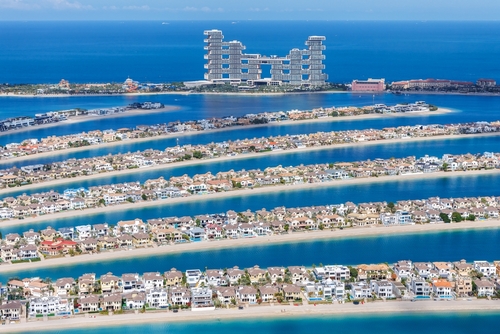Dubai is famous for its stunning skyscrapers and luxurious lifestyle. Its rapid growth has led many to ask: is Dubai a man-made city? The answer is complex. While much of what makes Dubai famous today is the result of incredible human engineering, the city itself grew from a natural settlement.
This article will explore the history of Dubai, from its origins as a small fishing village to the global hub it is today. We will look at the man-made marvels that define its landscape and explain how they were built. Understanding this transformation helps to appreciate the vision and effort that shaped modern Dubai.
Dubai’s Origins: From Desert to Metropolis
Before its modern transformation, Dubai was a small coastal settlement. It was established in the early 18th century along the banks of a natural saltwater inlet, now known as Dubai Creek. For many years, its economy was based on fishing, pearl diving, and trade. The creek provided a natural harbor, making it a convenient stop for merchant ships traveling between Mesopotamia and the Indus Valley.
The discovery of oil in the 1960s marked a turning point. Revenue from oil exports provided the funds for massive development projects. Dubai’s leaders invested in infrastructure, including roads, schools, and hospitals, laying the foundation for the city’s future. This period of rapid growth set the stage for the ambitious construction that would later make Dubai world-famous.
The Man-Made Marvels of Dubai
While the original settlement of Dubai was natural, many of its most iconic features are man-made. These projects were designed to overcome geographical limitations, create new land for development, and establish Dubai as a premier destination for tourism and business.
Palm Jumeirah
Perhaps the most famous of Dubai’s man-made islands, Palm Jumeirah is an artificial archipelago shaped like a palm tree. Construction began in 2001 and involved reclaiming land from the sea. Over 94 million cubic meters of sand were dredged from the Persian Gulf and sprayed into place using GPS technology to create the island’s precise shape. A curved breakwater, built from seven million tons of rock, was constructed to protect the island from waves. Today, Palm Jumeirah is home to luxury villas, hotels, and resorts, adding over 50 miles of coastline to the city.
The World Islands
Another ambitious project, The World Islands is a collection of 300 private islands arranged to resemble a map of the world. Located just off the coast of Dubai, construction began in 2003. Like Palm Jumeirah, it was built by dredging sand from the sea floor. The project aimed to create an exclusive community of private homes, resorts, and estates. While development has been slower than anticipated, the islands remain a testament to Dubai’s engineering capabilities.
Dubai Marina
The Dubai Marina is an artificial canal city built along a two-mile stretch of the Persian Gulf shoreline. To create the marina, developers brought water from the Gulf into the desert, carving out a new waterfront. The area is now surrounded by skyscrapers, apartment buildings, and villas, and it is one of the largest man-made marinas in the world. This project transformed a barren stretch of desert into a vibrant urban community.
Burj Khalifa and Downtown Dubai
Though not built on reclaimed land, the area of Downtown Dubai, including the iconic Burj Khalifa, represents a massive man-made transformation. What was once a sparse, low-rise area is now a bustling city center. The Burj Khalifa, the world’s tallest building, stands as a symbol of modern Dubai’s ambition. The surrounding area includes The Dubai Mall, the Dubai Fountain, and numerous hotels and residences, all part of a master-planned development that has become the heart of the city.
Building on Sand: The Engineering Process
Creating these massive structures required groundbreaking engineering techniques. The process of building Dubai’s man-made islands is a great example of this innovation.
- Dredging: Giant dredging ships collected sand from the deep sea floor of the Persian Gulf. This sand was chosen because its coarse grains are less susceptible to erosion compared to finer desert sand.
- Sand Placement (Rainbowing): The ships then sprayed the sand into position with high-pressure nozzles, a technique known as “rainbowing” because of the arc of sand seen during the process.
- Vibro-Compaction: Once the sand was in place, a process called vibro-compaction was used to pack the grains tightly together, ensuring the new land was stable and ready for construction.
- Breakwaters: To protect the islands from the sea, massive breakwaters were constructed using layers of rock. These structures were carefully designed to withstand waves and currents.
This process, repeated on a massive scale, allowed Dubai to create entirely new landmasses from the sea, showcasing a remarkable feat of modern engineering.
Is Edinburgh Castle a Man-Made Structure Like Dubai?
While Edinburgh Castle stands as a symbol of Scotland’s heritage, it’s fundamentally different from the man-made marvels of Dubai. To truly appreciate its significance and architectural evolution, one must take the time to explore the history of edinburgh castle, uncovering tales of royalty and resilience embedded within its stone walls.
So, Is Dubai Man-Made?
The best answer is that Dubai is a city with natural origins that has been extensively shaped by human ambition. The original town of Dubai grew organically around a natural creek. However, the modern metropolis known for its luxury and innovation is largely a product of visionary leadership and incredible engineering.
The city’s iconic landmarks—the palm-shaped islands, the world map archipelago, and the towering skyscrapers—are all man-made creations. They were built to attract global attention and diversify the economy beyond oil. In that sense, while Dubai is not entirely man-made from its very foundations, its modern identity and global status are the direct result of human ingenuity.
